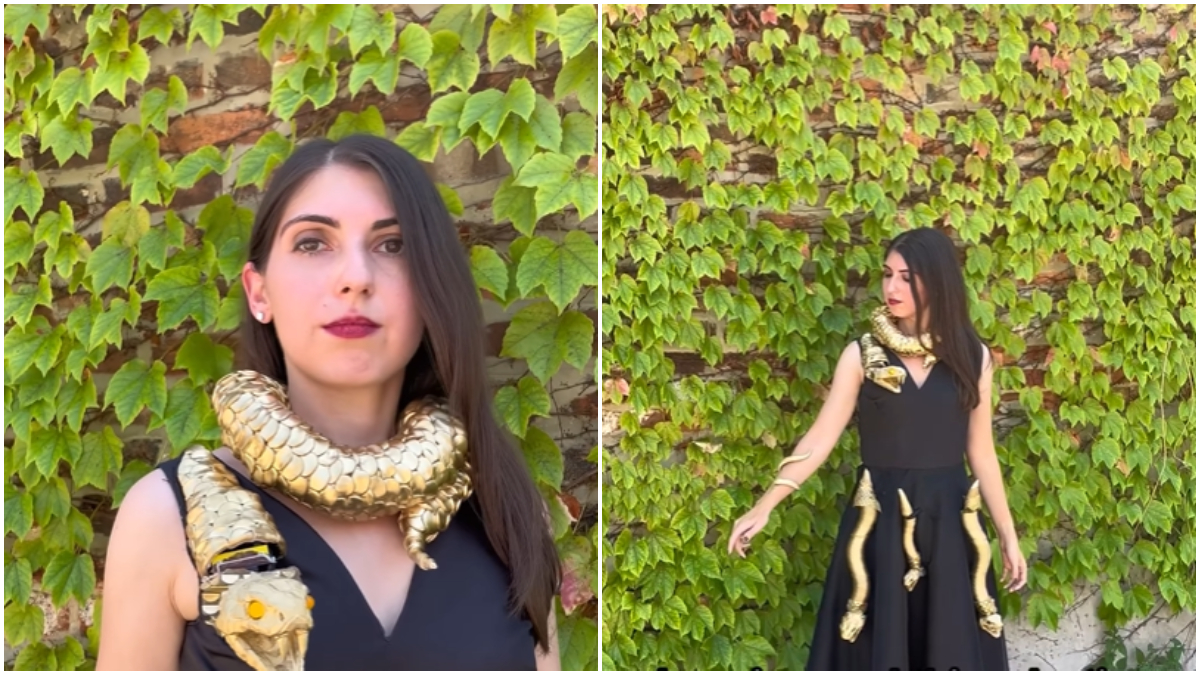A Google employee recently created the “world’s first AI dress” and it has astonished many on the internet. Christina Ernst, a software engineer at the tech giant and the Founder of SheBuildsRobots.org, a platform that aims to educate girls on building robots, shared a clip of her creation which has robotic snakes attached to it to detect faces.
Who Created the AI Dress?
Christina Ernst isn’t just a software engineer at Google; she’s a trailblazer in the tech and fashion world. With a deep passion for robotics and a commitment to educating the next generation, Christina founded SheBuildsRobots.org. Her platform is dedicated to teaching young girls the intricacies of building robots, encouraging more female participation in STEM fields.

Inspiration Behind the AI Dress
The idea for the AI dress stemmed from a unique intersection of fashion and technology. Christina wanted to create something that was not only aesthetically pleasing but also functionally innovative. The concept of the “Medusa dress” was born out of a desire to merge her love for robotics with a striking fashion statement.
✅ Also Read: Denmark Set to Impose World’s First Carbon Tax on Gassy Cattle
Design and Features of the AI Dress
The Medusa dress is a masterpiece of modern design. It’s predominantly black, adorned with three golden-colored snakes around the waist and one large robotic snake around the neck.
The snakes aren’t just decorative; they’re equipped with AI capabilities to detect faces and respond to onlookers, making them an interactive piece of clothing.
Technological Aspects
Creating the Medusa dress required extensive coding and programming. Christina incorporated an AI mode that allows the robotic snake heads to detect faces and move towards the person looking at them. This involved complex algorithms and precise engineering to ensure smooth and accurate movements.
The Making of the AI Dress
The creation process was meticulous and challenging. Christina shared that she spent countless hours developing and refining the dress. From initial sketches to final programming, every step required careful planning and execution. The integration of robotics with wearable technology was particularly demanding, requiring innovative solutions to ensure comfort and functionality.
Failed Prototypes
Before achieving the final version of the Medusa dress, Christina went through several failed prototypes. She openly shared these failures on social media, highlighting the iterative nature of innovation. Each failed attempt provided valuable insights, ultimately leading to the successful creation of the AI dress.
Public Reaction
The internet’s reaction to the Medusa dress has been overwhelmingly positive. Social media platforms were abuzz with comments and shares, with many praising the ingenuity and creativity behind the project. The dress not only captured the imagination of the public but also sparked discussions about the future of fashion and technology.
Impact on Fashion
The Medusa dress is more than just a novelty; it represents a significant step forward in fashion technology. By integrating AI with clothing, Christina has set a new trend that could revolutionize the fashion industry. The dress demonstrates the potential for garments to be both stylish and interactive, paving the way for future innovations.
Educational Implications
Through SheBuildsRobots.org, Christina aims to inspire young girls to pursue careers in robotics and AI. The Medusa dress serves as a powerful example of what can be achieved when creativity meets technology. By showcasing her work, Christina hopes to encourage more girls to explore the possibilities within STEM fields.
✅ Also Read: India is the World’s Second Largest Emitter of Nitrous Oxide
Surveillance Concerns
While the AI capabilities of the Medusa dress are impressive, they also raise important questions about privacy and surveillance. The ability of the dress to detect and respond to faces highlights the potential for wearable technology to be used in ways that could infringe on personal privacy. It’s crucial to consider these ethical implications as we move forward with such innovations.
Future Prospects
The Medusa dress is just the beginning. Christina Ernst envisions a future where AI and fashion are seamlessly integrated, creating garments that are not only beautiful but also intelligent. She plans to continue pushing the boundaries of what’s possible, with future projects that promise to be even more groundbreaking.
Comparisons with Other AI Fashion Innovations
The Medusa dress stands out in the world of AI fashion. While there have been other notable innovations, such as 3D-printed garments and smart fabrics, the interactive element of the Medusa dress sets it apart. Its ability to engage with its surroundings makes it a unique and pioneering piece.
Expert Opinions
Experts in both fashion and technology have weighed in on the significance of the Medusa dress. Many see it as a glimpse into the future of fashion, where AI and wearable technology will play a central role. The consensus is that this dress is a bold step towards a new era of intelligent fashion.
Conclusion
The “world’s first AI dress” with robotic snakes is a remarkable achievement that blends fashion, technology, and creativity. Christina Ernst’s innovative approach has not only captivated the internet but also opened up new possibilities for the future of fashion. As we continue to explore the potential of AI, it’s exciting to think about what other groundbreaking creations lie ahead.
FAQs
Christina was inspired by the idea of merging fashion with technology, creating a piece that is both visually striking and functionally innovative.
The dress is programmed with AI capabilities that allow the robotic snake heads to detect and respond to faces, moving towards the person looking at them.
Christina encountered several challenges, including integrating robotics with wearable technology and ensuring the comfort and functionality of the dress.
The public reaction has been overwhelmingly positive, with many praising the creativity and ingenuity behind the dress.
The future of AI in fashion looks promising, with potential advancements that could further integrate technology with clothing, making garments more interactive and intelligent.
Source: news24online
Related News:
No post found!
